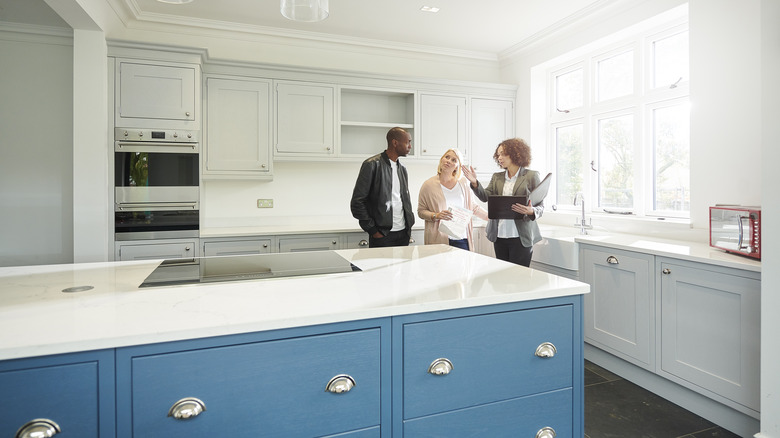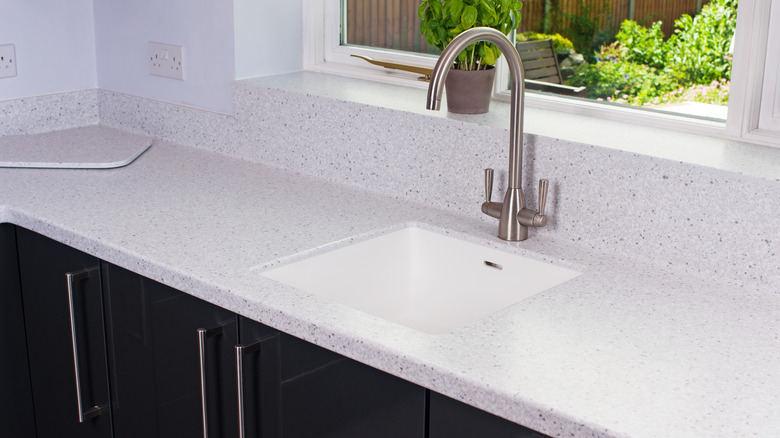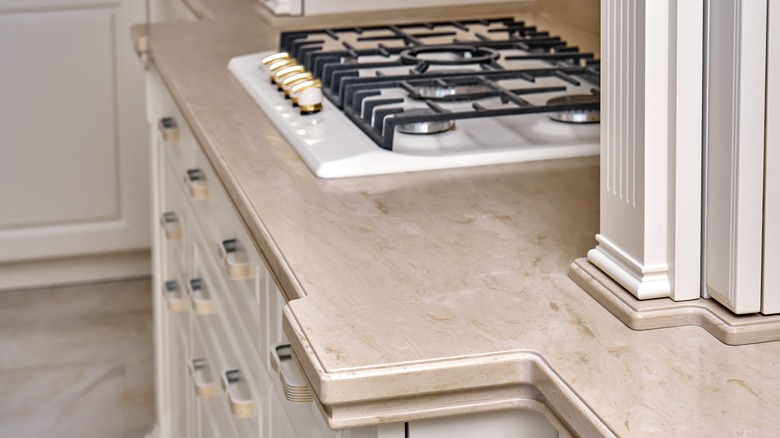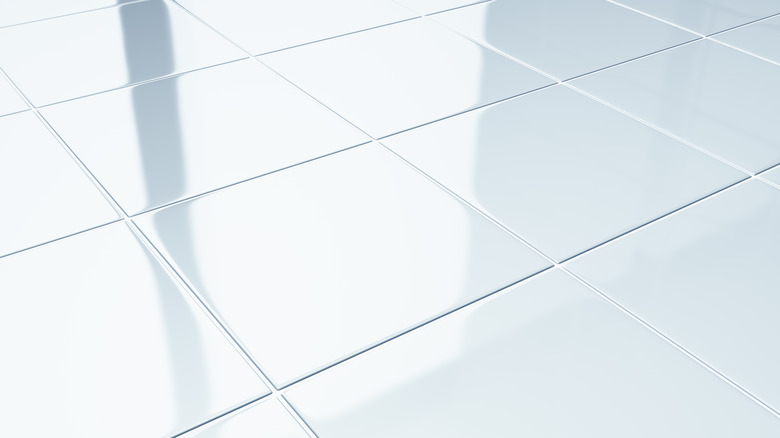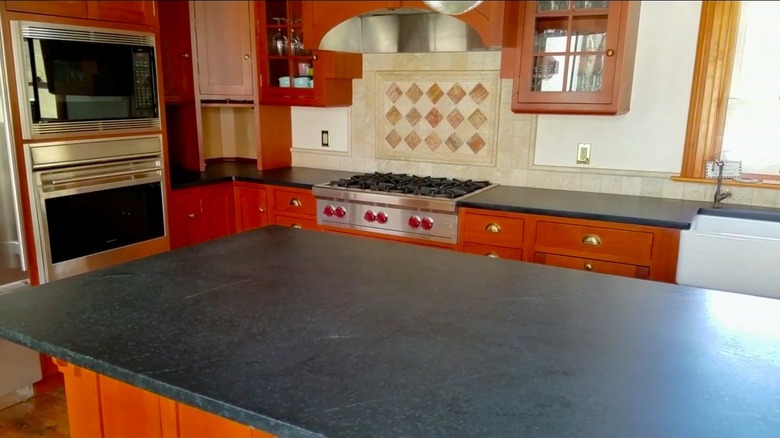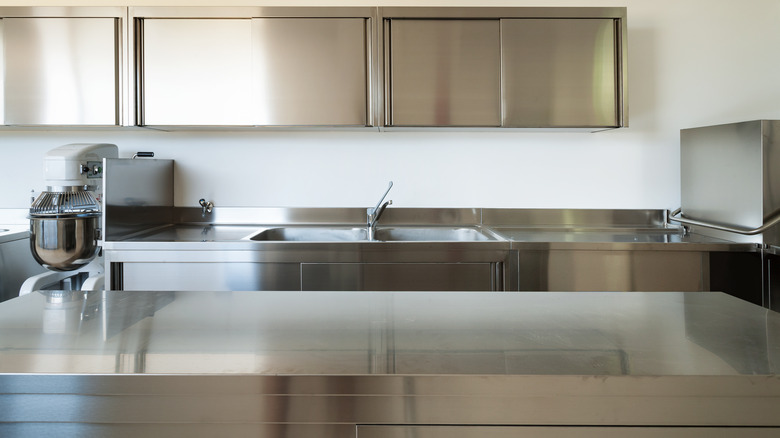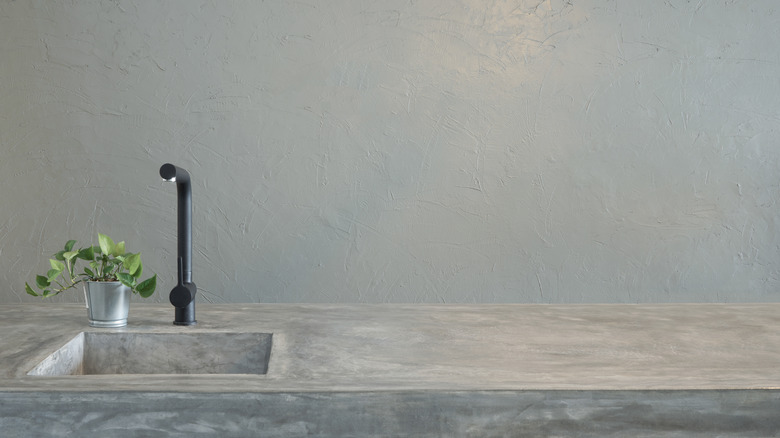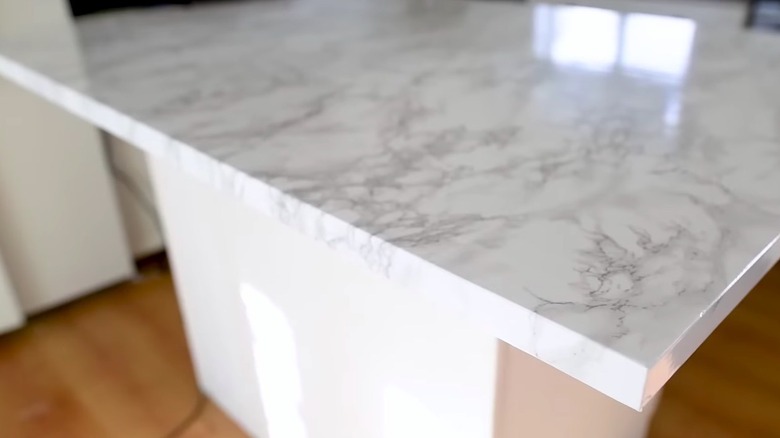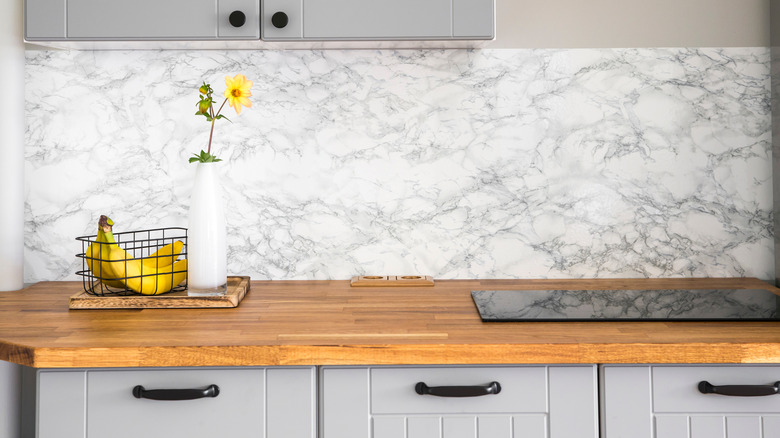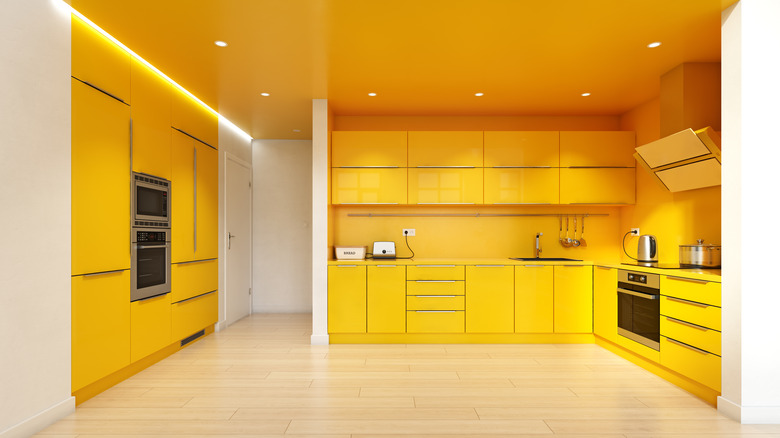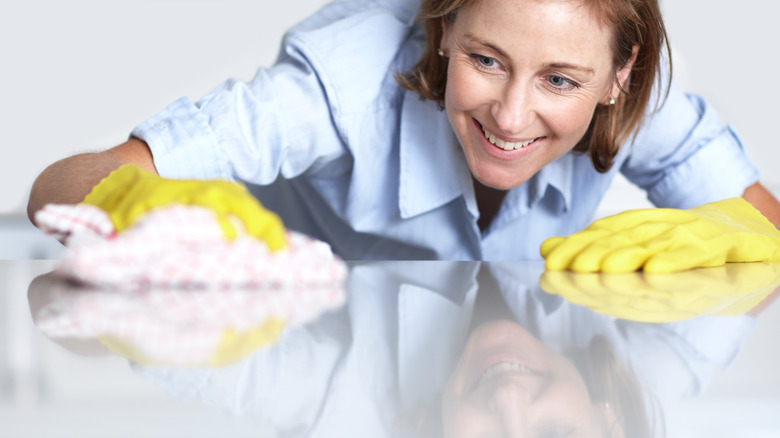Countertop Choices That Are Making It Harder For You To Sell Your House
A survey cited by the National Association of Realtors showed that 55% of potential buyers would consider a house with an impressive kitchen even if they don't love the rest of the property. There's no question that this room stands out when searching for a property. Homeowners long for a space where they can prepare food with ease, comfort, and style. And, your countertops play a big role in this as these work surfaces are some of the busiest in the house. They need to endure numerous activities and come in contact with various items including hot pans, sharp knives, oily liquids, and more.
So, when determining the factors that buyers will weigh for your house, countertops undeniably count — do excuse the pun. The options can vary widely depending on the type of material and finish. Each one may be better or worse than others in certain respects. If your kitchen fails to spell love at first sight (or touch), you may have to rethink your choice. The good news is that, in many cases, it's possible to upgrade your countertop at a cost within your sales prep budget. But to begin with, let's first determine if yours is a guilty sale-choker.
Laminate isn't very durable and impossible to repair
Laminate countertops are a cost-saving choice, no question about it. Other than that, however, they have very few other advantages over other types. Laminate surfaces are prone to all sorts of damage including scratches, burns, peeling, and warping. This is because its composition is synthetic which, though relatively easy to produce, does not compare to the strength and rigidity of natural stone. What's worse is that most damage is practically impossible to repair and fixes can be very visible. Instead of patching or fixing them, you will need to take out the entire slab and replace it.
Overall, many potential buyers see them as a cheap choice and an inevitable problem in the future. Sure, they've already improved since their heyday and come in countless designs imitating surfaces such as stone, wood, and ceramic. However, even when they look nice from afar, the feel and quality are likely not going to attract top dollar from buyers, especially in a high-end market.
Solid surface doesn't match up to real stone
Solid-surface countertops are made from a mixture of natural minerals and acrylic polymers. They have grown very popular commercially as a less expensive alternative to natural stone materials. Many lay and non-laymen refer to the product using well-known brand names such as Corian or Wilsonart. However, the generic term is solid-surface or manufactured stone.
Solid surfaces are versatile, just like laminate. They are also resistant to stains and very convenient to clean, making them a low-maintenance choice. However, the fact that they are partly synthetic means they are not as tough as substances like granite or quartz. They are prone to scratches and can sustain damage when in contact with hot items and chemicals. So, while buyers may like the look of solid surface counters, the lack of durability may cause them to be cautious. In fact, they fetch a lower resale value than higher-end options.
Tiles are not a hygienic choice
Tile countertops may take you back to the lively home kitchens of the '70s and '80s or to Mediterranean or Moroccan mansions. Inexpensive, flexible, and surely retro, this surface has its fair share of notable benefits. They arguably have the widest range in terms of appearance and price of all the categories. Because the surface is segmented, tile countertops are very easy to repair. If one or two tiles get cracked, they can simply be replaced as long as you can source the same tile design that you originally used.
However, not every buyer is looking for a nostalgic touch. When they glimpse tile countertops, their mind may immediately jump to the idea that your property is dated and needs a major refresh. Plus, tile harbors dirt and bacteria, and requires a lot of cleaning. The grout lines collect residue, grease, and other unwanted substances. Cleaning tile countertops will take more than a few wipes and requires plenty of scrubbing and regrouting from time to time. This is an inconvenience that a buyer may not like envisioning in a new home.
Soapstone looks great but is defenseless against scratches
Soapstone has a distinct grey shade that exudes sophistication and luxury. This soft surface offers a distinct look and warm feel that is recognizably different from other high-class options such as granite, quartz, and marble. Soapstone is composed of talc and various mineral deposits, and is an environmentally-friendly choice because it is a naturally occurring substance and not manufactured.
Like the other countertop choices we've mentioned, soapstone has its pros and cons. In this case, unfortunately, the latter may be more apparent to home buyers. As designer Shauna Beltramo points out, choosing the material was the worst design mistake she has ever made. She explained that "...scratches were happening within the very first few days of living in our brand new home." So, even if you have fresh soapstone counters installed, it's unlikely that buyers will be able to look forward to long-term beauty.
Stainless steel is expensive and lacks that homey feel
The industrial look has been gaining popularity in the past several years and can be seen being applied by designers in numerous establishments. More than just a trend, there are advantages to this approach in terms of maintenance and flexibility. For home kitchens, some incorporate this concept by using materials such as stainless steel. This high-grade metal is durable and can last for a very long time with proper care.
Nonetheless, even with all those promising qualities, the downsides of stainless steel countertops are just too overwhelming for many prospective homeowners. Though it stands up against rust and stains, stainless steel is not safe from scratches and dents. Dropping a pan or a chopping board can cause very visible deformations, only amplified by the reflective surface. On top of these, probably the biggest drawback from a buyer's perspective is the aesthetic. Stainless steel lacks the warmth and welcoming vibe that many house hunters are looking for in a kitchen.
Concrete equals maintenance issues
Another popular finish, thanks to the industrial look trend, is bare concrete surfaces. And kitchen countertops are no exception. Concrete brings an interesting aesthetic flavor with its rugged, unconventional appearance. This flexible material can actually be modified into various colors, finishes, and shapes. Some artisans can configure it to look like wood or solid rock. However, these custom installations don't change the core features of the material.
The factor that puts concrete on the bad-choice list is that it is a porous material that can cause several issues for new owners. This means it cannot retain moisture on its surface and absorbs it instead. All the sauces, juices, oils, and liquids can seep into it and turn into a microbial settlement, not a great feature in a busy kitchen. To avoid this happening, concrete requires regular wax-sealing which is not a good selling point to potential investors.
Contact paper is not a good long-term investment
Contact paper has numerous names, but regardless of the label, the concept is pretty similar. It is a synthetic sheet that has an adhesive surface on its backside. It is usually applied to countertops, cabinet panels, wall sections, or even flooring. Though popularly described as paper, most products available today are actually made of vinyl. It is effective in covering cracks and stains, or simply changing or refreshing the existing look of surfaces. Because it's printed digitally, it can come in a multitude of patterns, colors, and imagery. It can imitate marble, granite, tiles, wood, and stainless steel, prompting some savvy DIYers to use it to revamp countertops.
But this is likely a red flag for buyers as contact paper is not meant for permanent use. While it's good for a quick, aesthetic change, it won't add selling value to a property and can be perceived as a cheap coverup. If that is not enough, the material is also prone to ripping and peeling and has limited resistance to high temperatures.
Butcher block is susceptible to cuts and burns
There is just something so pleasantly warm and nostalgic about wood. Being an organic material with its grains and rings exposed, it adds a calming feel of nature and life to any space. Though closely resembling the massive boards used for cutting meat and fish, butcher block refers to an unsegmented quadrangular piece of lumber used as a countertop.
However, while it may be a welcoming sight to buyers, they may turn away when they learn about the durability and rigorous care requirements. It is usually polished and then needs to be regularly sealed with wax, oil, or organic polymer (Polyurethane) to shield it from stains. This offers some protection, but it does not completely safeguard it from other damages such as cuts and scratches. Plus, hot pans can burn the butcher block, leaving a mark. This isn't exactly a feature that says, "functionality," to potential homeowners.
Yellow countertops are not cool
The type of material is a major consideration, but sometimes, buyers can also be put off by the countertop color. Typically, this particular choice is subjective to personal preferences. For example, you may want to inject a little cheer into your kitchen using a yellow hue. This can be done with different countertop materials and in various intensities of the hue.
However, according to some interior design professionals, yellow is a no-go in the kitchen. You may love seeing the pop of color with your morning coffee but prospective owners might not embrace such a bold statement. It's no secret that buyers want to see themselves in your space and more neutral surfaces allow them to do so. Plus, yellow can backfire from its seemingly cheerful impact. Real Homes interim editor, Lindsey Davis, tells Express UK, "Though a sunshiney hue can feel invigorating, this can quickly bubble over to stress when you are trying (and failing) to multitask, or have too many people buzzing around at meal times."
Too much gloss is a loss
The finish is one more aspect to consider in addition to the type of material and color. Referred to as luster or sheen, this quality pertains to how much light a certain surface reflects. The more reflective it is, the more glossy it appears. Because it's such a large surface, selecting the right finish for your countertops can drastically alter the appearance and feel of your kitchen.
Too shiny of a surface can cause glaring which is distracting and causes discomfort to the eyes, creating poor first impressions on home buyers. This problem is intensified in kitchens that receive lots of natural light. Fingerprints and imperfections such as scratches and dents are more visible too, making it apparent the upkeep will require a lot of work. On the other hand, a satin or matte finish can create a blank canvas to style a kitchen around. Plus, they hide fingerprints and imperfections, ideal features for those envisioning their new busy kitchen.
